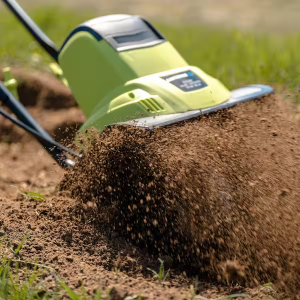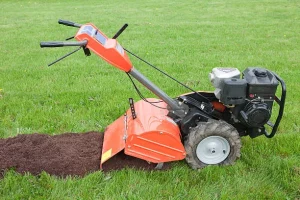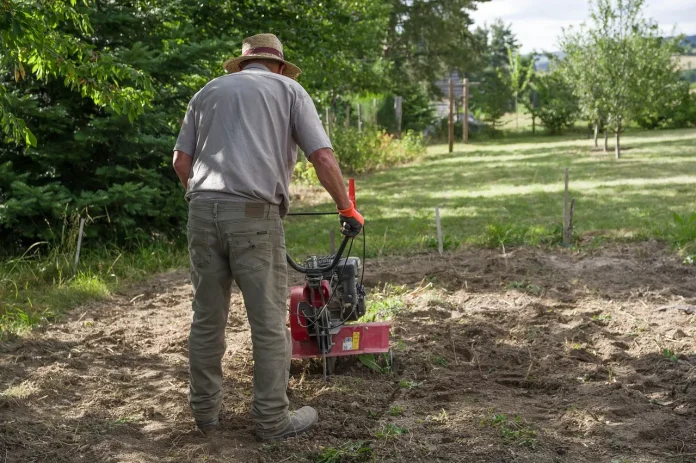Picking the right cultivator can make or break your farming season. Whether you’re loosening soil for a veggie patch or keeping weeds in check on a bigger plot, the wrong tool wastes time and energy—something no farmer can afford. Take my neighbor Jim, who spent last season fighting a bulky gas machine that was overkill for his small garden, while I buzzed through my rows with a lightweight electric model.
Understanding Cultivator Types
Knowing your options is the first step to picking the best cultivator. Electric cultivators run on power, coming in corded or cordless models, while gas-powered cultivators rely on gasoline engines, known for their muscle and mobility. Here’s what each brings to the table—and where they fall short.
Electric Cultivators: Powered by Electricity

These machines plug into an outlet or use batteries, making them a hit for small to medium farms.
- Pros:
- Quiet as a whisper—no earplugs needed.
- No gas means no fumes or fuel runs to the station.
- Lightweight and easy to maneuver around tight spots.
- Low upkeep—just charge or plug in and go.
- Cons:
- Corded models tie you to an outlet; cordless ones lean on battery life.
- Less power for breaking up hard, rocky ground.
Gas-Powered Cultivators: Fueled by Gasoline

Built with gas engines, these are the heavy hitters farmers turn to for big jobs.
- Pros:
- Strong enough to chew through clay or tough soil.
- No cords or batteries—move freely across big fields.
- Handles larger plots without slowing down.
- Cons:
- Noisy—your neighbors might hear it a mile off.
- Needs regular tune-ups, oil, and gas refills.
- Heavier, so it’s a workout to push around.
Which One Should You Choose?
So, electric or gas—which cultivator fits your farm? It depends on your land, your tasks, and how much grunt you need. Check out this table—it’s packed with details to help you decide based on real farming needs, from backyard plots to sprawling fields.
| Factor | Electric Cultivator | Gas-Powered Cultivator |
|---|---|---|
| Best For | Small to medium farms, gardens, raised beds | Medium to large farms, new or tough ground |
| Farm Size | Up to 2,000 sq ft—think veggie patches | Over 2,000 sq ft—big fields or pastures |
| Soil Type | Loose or sandy soil, already worked beds | Hard clay, rocky soil, or virgin land |
| Tilling Depth | 6-9 inches—great for shallow mixing | 8-12 inches—deeper for serious digging |
| Power Source | Corded (unlimited) or battery (20-40 min) | Gas tank—runs as long as you’ve got fuel |
| Weight | 20-40 lbs—easy on the arms | 50-100 lbs—takes more muscle to handle |
| Noise Level | Quiet—won’t spook the chickens | Loud—bring ear protection |
| Maintenance | Plug in or charge, no oil or filters | Oil changes, spark plugs, and gas refills |
| Mobility | Cord limits range; cordless needs recharging | Go anywhere, no cords or batteries to worry |
| Eco-Friendliness | No emissions—keeps the air clean | Burns gas—leaves a carbon footprint |
| Upfront Effort | Push a button and start | Pull a cord, might need a few tries |
| Best Task | Weeding rows, aerating beds | Breaking new ground, heavy-duty prep |
Electric cultivators shine when you’ve got a smaller setup or want something simple to use around the barn. Gas-powered ones step up for the big leagues—tough soil or wide-open spaces where power trumps all. Pick what matches your daily grind!
Case Studies: Real Farmers, Real Results
Nothing beats hearing from folks who’ve put these cultivators to work. Here are two stories from farmers like you—one with an electric model, one with gas—showing how they fit into real farm life.
Case Study 1: Sarah’s Small Farm with an Electric Cultivator
Sarah runs a 1,500-square-foot veggie farm in Ohio, selling at the local market. She picked a corded electric cultivator last year after her old gas one kept waking the roosters. “I’ve got raised beds and sandy soil near the barn,” she says. “This thing’s quiet and light—I can zip between rows in an hour without breaking a sweat.” She plugs it into an outlet by her shed, and the 16-inch tines fluff up her soil perfectly for carrots and lettuce. The only hiccup? She wishes the cord stretched farther for her back fence line. For her small setup, it’s been a time-saver with no gas cans to fill.
Case Study 2: Mike’s Big Plot with a Gas-Powered Cultivator
Mike’s got a 5-acre spread in Texas, growing corn and soybeans on clay-heavy land. He went with a gas-powered cultivator two seasons back when he expanded into an overgrown field. “It’s loud and heavy, but man, it tears through that hard ground like nothing else,” he says. The 10-inch deep tilling got his new plot ready in a weekend—something an electric model couldn’t touch. He spends an extra 15 minutes a month on oil and spark plugs, but for him, the freedom to roam his fields without a cord is worth it. It’s his go-to for big, tough jobs.
Conclusion
Choosing the best cultivator comes down to what your farm needs. Electric models keep it simple and quiet for small plots—think Sarah’s veggie beds in Ohio. Gas-powered ones bring the muscle for big, rugged land, like Mike’s Texas fields. Look at your soil, your space, and how much work you’re putting in. A lightweight electric cultivator saves hassle on smaller jobs, while a gas beast handles the heavy lifting. Match the tool to your task, and you’ll be set for a season that runs smooth and strong!

